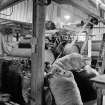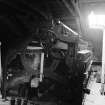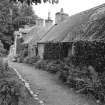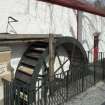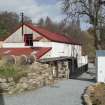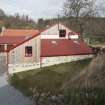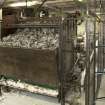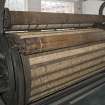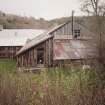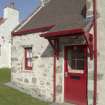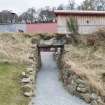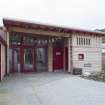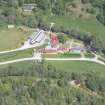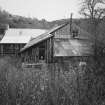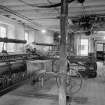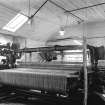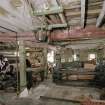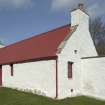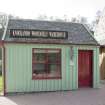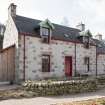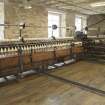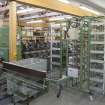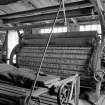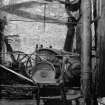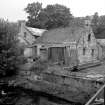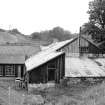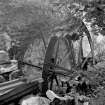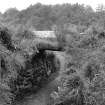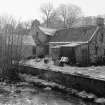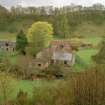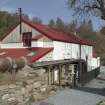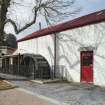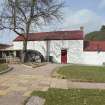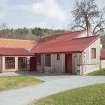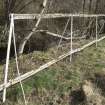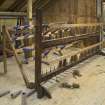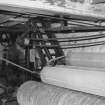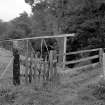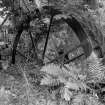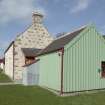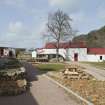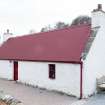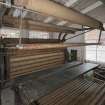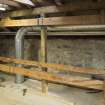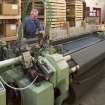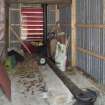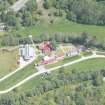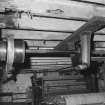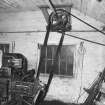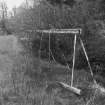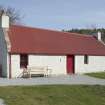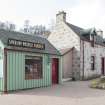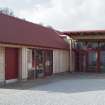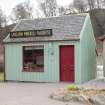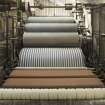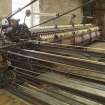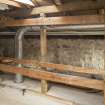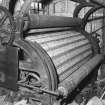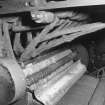Knockando, Woolmill
Woollen Mill(S) (19th Century)
Site Name Knockando, Woolmill
Classification Woollen Mill(S) (19th Century)
Alternative Name(s) Cardow Mills; Woollen Mills
Canmore ID 16056
Site Number NJ14SE 20
NGR NJ 18793 42572
Datum OSGB36 - NGR
Permalink http://canmore.org.uk/site/16056
First 100 images shown. See the Collections panel (below) for a link to all digital images.
- Council Moray
- Parish Knockando
- Former Region Grampian
- Former District Moray
- Former County Morayshire
NJ14SE 20.00 NJ 18793 42572
NJ14SE 20.01 NJ 18802 42539 House
NJ14SE 20.02 NJ 18787 42547 Cottage
NJ14SE 20.03 NJ 18779 42547 Principle Bothy, Southern Range
NJ14SE 20.04 NJ 18775 42549 Principle Bothy, Northern Range
NJ14SE 20.05 NJ 18771 42552 Secondary Bothy, Southern Range
NJ14SE 20.06 NJ 18767 42553 Secondary Bothy, Northern Range
Woollen Mills [NAT]
OS 1:10,000 map, 1976.
NJ 1878 4258. Small L-plan waulk mill of early 19th-century date situated on the Knockando Burn, converted about 1870 to spinning, and with later 19th-century lean-to additions, forming the smallest possible vertically-integrated woollen mill. This is the smallest textile mill in Scotland to retain its plant, and, although closed, is of specific interest for this.
NMRS MS/712/9.
Publication Account (2007)
RCAHMS is undertaking a survey of Knockando woollen mill and cottage at the request of Laura Norris, then of the Alba Conservation Trust, in support of their bid for Lottery Funding, and in order to set the limited RCAHMS survey of 1996, which was restricted to the mill itself, into the context of the surrounding buildings. The survey will include the tenter frame, the mill lade and the derelict Woolmill Cottage which retains a remarkable timber boarded interior.
The mill dates from the early nineteenth century with later additions. It is one of the smallest surviving vertically integrated woollen mills with fully operating century textile machinery still in-situ. It was originally built as a small, single storey and attic, rectangular-plan waulk mill, and the addition of the two-storeyed carding and spinning mill in the mid nineteenth century created an L-plan. Both are built of random rubble with corrugated-iron roofs. The mill was further enlarged in the late nineteenth century with a sizeable weather-boarded L-plan lean-to attached to the re-entrant angle,built to house further carding and spinning equipment, with large windows and corrugated-iron roof.
Woolmill House is said to date from 1896, but it appears to be on the site of an earlier building, and has been thoroughly modernised in the late twentieth century. Woolmill Cottage, which dates from the earlier nineteenth century, is a simple, traditional, single storey, three-bay, rectangular-plan symmetrical structure, located to the south of the mill, with a small, roofless, square-plan dairy/larder attached to south-east gable. The harling remains in places, with coursed random rubble with ladder pinnings evident elsewhere. It has a pitched corrugated asbestos roof.
The interior consists of a small hallway inside the front door, with doorways leading off to the principal gable end rooms, and a narrow central room running to the rear. There are timber sixpanelled fielded doors; a small cast-iron range and a bed recess is found in one of the principal rooms, and a cast-iron register grate in the other. The timberlined walls are partially exposed.
Information from ‘Commissioners’ Field Meeting 2007'.
Note (2013)
Machinery at Knockando’s Woolmill:
Machines presented by Hugh Jones, weaver. He has always known the machines since he arrived. As a group, the machinery has been here for at least 120 years.
Carding set:
The carding set dates for the main part from the 1880-1890’s, except for the automatic feed (1919) and the last part (1872).
Hopper: 1919
Patent automatic feeding machine co. LTD Rochdale.
Scribbler: c.1880’s
The mention "RHS1" is written on the frame of the first set of rollers.
Spinning department:
Self-acting mule: 1870. Platt Brothers &Co Limited.
Weaving department:
Dubcross industrial weaving loom: 1899. Hutchinson, Hollingworth & Co (Lancashire). It weighs two and a half tons. It was one of the most successful weaving looms of the time.
Information gathered by Survey and Recording Section (M McDonald), Architecture and Industry, Heritage Directorate, HES, 2013.
Note (7 April 2015)
Knockando woollen mill consists or restored mill house, cottage, textile mill, mill pond, new visitor centre and new weaving shed (which was built as the conservation workshop). The mill itself is a two-storey, wood-framed, masonry build with corrugated roof with wooden gable barge boards and dates in its present form from the 1860s. The power source was a lade was piped to an overshot water wheel, replaced in 1949 by electricity.
Sir William Roy's map of 1749 (Roy Military Survey of Scotland 1747-55,see http://maps.nls.uk/geo/roy/#zoom=14&lat=57.4506&lon=-3.3160&layers=roy-highlands) depicts buildings at Knockando, near the current mill site. In 1784 a William and Ann Grant are noted as having possession of the mill and croft and there are references to a waulkmill fulling/shrinking woollen textiles. The Grants held it until the 1830s when it changed hands. In the early days (by 1829, the tear of the great flood) the mill would have scoured, dyed, waulked and tentered woollen textiles while spinning and weaving would be put out as piece work to the community. Hand-cranked carding machines and a partially automated spinning mule were installed. Weaving was introduced in 1848. The census of 1851 notes a wool carder, spinner and weaver on site. By 1861, spinning of wool by hand and weaving done on a handloom. Eighteen acres of land was rented from the local Laird with some cattle, potatoes, oats, turnips and barley grown.
In 1864 a new mill building was built and water power installed by A. Smith and Son (with the 14 feet diameter waterwheel installed in the 1870s (second hand from a former meal mill at Pitchroy; the waterwheel pit was deepened)) but the mill work was still mostly done by hand. In the 1880s, the weaving shed was added to accommodate the power looms installed.
In 1904 the spinning mule was installed and the pipes laid to carry the water from the mill pond to the waterwheel (which meant remodelling the lade) and the extension of the south west to allow the insertion of the carding sets (bought second hand from Laidlaw's Mill in Rothimay).
Knockando was at its peak in the period 1902 - 1938. In 1919 the automatic feed set was bought to automate the feeding of wool into the carding machine. Knockando produced blankets for the First World War through Government contracts. It was at this time (1915) that the drying shed was built.
The woolmill house was built in 1903 and the old byre cottage was demolished. In 1945 another great flood destroyed the 1880s weaving shed. In 1949 the waterwheel was disconnected as electricity enabled the instalation of small electric motors on the machinery. The Knockando Wool Trust was founded in 2000. Since 2012, with the large scale restoration of buildings and machinery, Knockando has continued to produce fine quality tweed.
Information from Knockando Mill, Visitor Centre, December 2014.










































































































